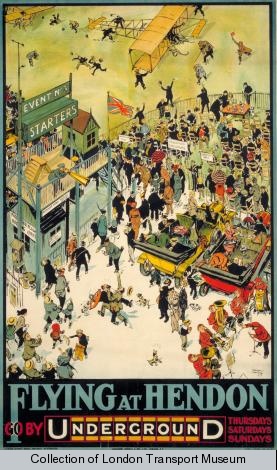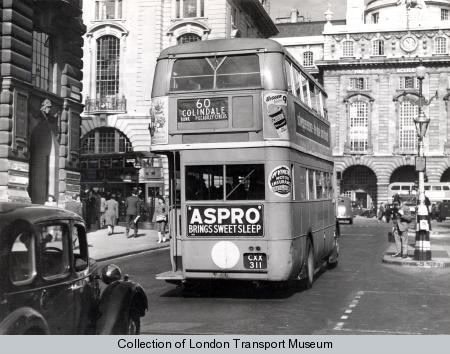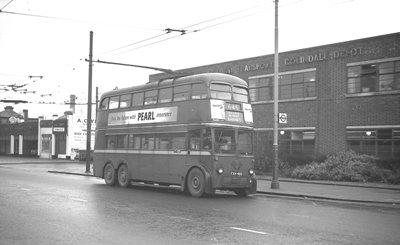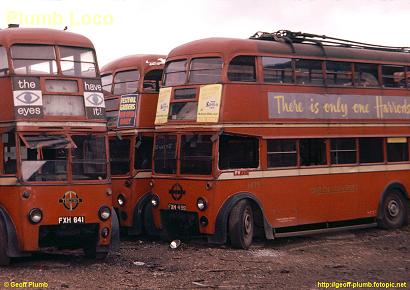The GNR line from Finsbury Park to Edgware via Highgate, Finchley
Central, Mill Hill East and Mill Hill The Hale opened
in 1867. This line became part of the pre-war Northern
Heights project, under which the Northern Line would be extended
beyond Highgate (the station now known as Archway) over existing
steam-operated rail lines. The line from Finsbury Park had
branches to High Barnet and Alexandra Palace, and the plans also
envisaged an extension north of Edgware to Bushey Heath.
Steam services ceased in 1939 and were replaced in part by
rail-replacement buses from Finchley Central to Edgware.

The war, and subsequent green belt
policy, meant that the Northern Heights project was never
completed. The extension from Archway to High Barnet opened
in 1940, and to serve the Mill Hill Barracks the branch to Mill
Hill East was electrified and opened, still as a single track, in
1941 – the last element in today’s Northern Line. The
Alexandra Park branch, which passed under Muswell Hill by a weak
bridge that forced London Transport to work the busy 212 with single-deckers, continued to operate a
shuttle from Finsbury Park until 1954, but the section between Mill
Hill East and Edgware never reopened to passenger traffic and
closed completely in 1964. Despite considerable work,
including the building of the depot (which later became LT’s
Aldenham Works), the extension north of Edgware was never
built.
Catch Jay Foreman's video commentary on the
Northern Heights project here. Five
points for spying the King Crimson snippet.
One of the classic posters
advertising the Underground - Hendon Aerodrome in 1914.
Image © London Transport Museum
The tube
The main tube line in the area is the Northern, whose Edgware
branch runs north from Golders Green via Brent Cross, Hendon
Central, Colindale and Burnt Oak to Edgware. The extension
north from Golders Green was built largely over open fields and was
opened in 1923 (to Hendon) and 1924. The eastern branch
divides at Finchley Central for Mill Hill East (see above) and High
Barnet via Totteridge & Whetstone, all former steam railway
lines.
To the west, the Jubilee Line to Stanmore started life in 1932
as a branch of the Metropolitan from Wembley Park, then in 1939
became part of the Bakerloo, finally in 1979 (for the Silver
Jubilee in 1977) the Jubilee Line.
Aeroplanes
Hendon Aerodrome, despite being marked optimistically on the
1930 map as 'London Aerodrome', never was an airport - before the
second world war, London's airport was at Croydon.
Rather, Hendon was principally a military establishment from the
first world war onwards, hence the lack of bus services to the
aerodrome.
Learn more about the history of the aerodrome at the
RAF Museum site.
 Bus
services to the aerodrome
Bus
services to the aerodrome
An early service to Colindale was route 60, from 1923
(before the tube station opened), with services from central
London to 'Hendon Colindale Avenue' terminating at the
Phoenix Telephone Works on Edgware Road. These
were extended to Colindale Station in 1925, with buses running
light from the station to turn on a 'private road
belonging to Grahame White Ltd' - the owner of the
aerodrome.
The exception was on the day of the annual RAF Display, when
buses did not run along Colindale Avenue, presumably because of the
crowds. Instead, extra buses were laid on from the Phoenix
Works, an arrangement that continued to 1930, when the service was
withdrawn north of Cricklewood outside peak hours.
STL1604 heads up Lower
Regent Street bound for Colindale in 1948.
Image © London Transport Museum
The entrance to the aerodrome was where now is the roundabout at
the junction of Grahame Park Way and Aerodrome Road; the private
road referred to was Booth Road, just short of the roundabout, into
which buses reversed to turn until 1947. It was only from
1953 that passengers were carried along Colindale Avenue and Booth
Road (as far as the turning point at Aeroville Road).
The RAF Display remained a magnet for the public, with
for example East Surrey (the precursor to the London
Transport Country Area) advertising a trip from Reigate in
their 1931 timetable. Bus services meanwhile continued to
serve only the station, with an outer section of London route 8
being replaced by the new 140 in
1932. The 79 also
served Colindale Station from the war years until after the
redevelopment of the aerodrome site in the 1970s. Meanwhile,
the years after trolleybus withdrawal saw 142 and 292 use
Colindale Annesley Avenue as a terminus, reminiscent of
the journeys that ended at the Phoenix Telephone Works.
Trams and trolleybuses
|

The running shed at Colindale Depot. The
open land behind was used by George Cohen's 600 Group to break up
the majority of the fleet.
Photo © Mike Beamish
|

L3 class 1462 stands outside the admin block of
Colindale Depot awaiting a new crew. The entrance to the
running shed is to the left.
Photo © Mike Beamish
|
Metropolitan Electric Tramways
launched the area’s first electric tram service in 1904 between
Cricklewood and Edgware, a relatively undeveloped area at the
time. The tram depot and the nearby hospital were the
stimulus for the first suburban development of Colindale, in
Colindale Avenue and Annesley Avenue. Elsewhere in the area,
trams were introduced between Whetstone and Highgate from 1905 and
extensions brought services to Canons Park in the west and Barnet
Church in the north by 1907.
 The Edgware trams operated from Hendon Tram
Depot adjacent to Annesley Avenue in Colindale, the scene in 1910
of the first trials in Britain of a trolleybus.
Trolleybuses replaced trams in 1936 and the depot
was renamed Colindale when Central Road Services was formed in
1950. The depot operated the 645 and 666 until January 1962,
when the depot was closed and demolished; the site on Edgware Road
is now occupied by Merit House.
The Edgware trams operated from Hendon Tram
Depot adjacent to Annesley Avenue in Colindale, the scene in 1910
of the first trials in Britain of a trolleybus.
Trolleybuses replaced trams in 1936 and the depot
was renamed Colindale when Central Road Services was formed in
1950. The depot operated the 645 and 666 until January 1962,
when the depot was closed and demolished; the site on Edgware Road
is now occupied by Merit House.
The end - trolleybuses await
their fate behind Colindale Depot.
Photo © Geoff Plumb
Land behind the depot was used from
1959 to 1962 by the George Cohen 600 Group for scrapping a large
number of London's trolleybuses - a range of photos and
notes are on Mike Beamish's
site, with views both of trolleybuses working in the
area and of the scrapping. A short video is on YouTube.